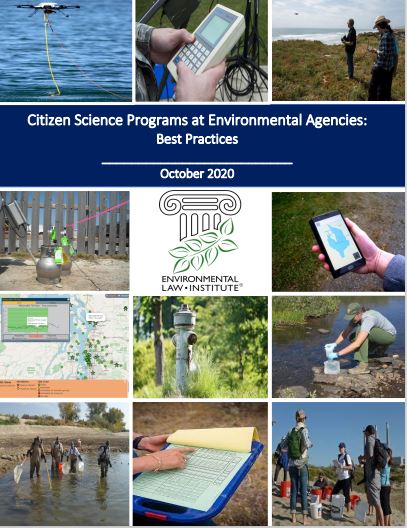Environmental agencies are increasingly transforming their approach to citizen science, from viewing it as a source of data primarily for education and awareness to a potential source of concrete value for their programs. Although this relationship has existed for some time, the emergence of new technologies, an increasingly aware public, and the rise of unexpected pollution events has reinvigorated the way agencies and the public work together.
 The Environmental Law Institute was recently asked by the U.S. Environmental Protection Agency to characterize existing and new ways citizen science is being adopted by environmental agencies, define the best practices, and identify strategic steps that can be taken to support the use of citizen science for environmental decision making.
The Environmental Law Institute was recently asked by the U.S. Environmental Protection Agency to characterize existing and new ways citizen science is being adopted by environmental agencies, define the best practices, and identify strategic steps that can be taken to support the use of citizen science for environmental decision making.
In response, ELI surveyed the experience to date of state, tribal and local environmental agencies and prepared in depth case studies of how they are using citizen science, working with citizen scientists, or creating ways for public reporting to support their programs. ELI also convened a series of conversations that brought together government officials, academics, policy advocates and others, for a deeper dive on the issues facing the agencies as they seek to work with citizen scientists. The resulting findings can be found in three newly released reports:
Citizen Science Programs at Environmental Agencies: Case Studies looks at 15 agency programs that actively involve the public to complement official agency action and establish a collaborative role in protecting the environment. While ELI sought to highlight a wide range of citizen science examples, the emphasis is primarily on air and water programs.
Citizen Science Programs at Environmental Agencies: Best Practices identifies best practices for environmental agencies that are interested in, or actively pursuing, citizen science. The best practices focus on generating reliable data, building a supportive network, and sustaining citizen science programs over the long term — seen as part of the core program and creating shared value for environmental agencies and the public. Each best practice is described in detail and supplemented with relevant examples from the case studies.
Enabling Citizen Science Programs at Environmental Agencies: Recommendations to the U.S. Environmental Protection Agency outlines a set of strategic recommendations to the U.S. EPA and other potential partners on how to facilitate the uptake of citizen science and sustain the use of citizen science across agencies and programs. The recommendations focus on steps to address a variety of issues and challenges that came to the fore in the case study research and stakeholder conversations. These include:
- Building awareness in agencies of the value of citizen science as a resource, and a proactive way of thinking about engaging with citizen scientists;
- Creating central leadership hubs to share information and provide policy direction (these hubs would be organized along program lines – air, water, etc.);
- Taking key steps to enhance the value of citizen science as a tool for communities, and build constructive working relationships between communities and agencies;
- Addressing concerns about data quality; and
- Building better systems for data sharing and ensuring good data management.
Though these challenges are significant, the opportunities that citizen science presents to both agencies and the public are substantial. One recurring theme found by ELI was the significance of citizen science (or community science) in the context of community-driven environmental efforts, especially in overburdened environmental justice communities. The ability to gather data independently changes the relationship between residents and government, giving local residents a more substantive role in defining problems as well as assessing environmental conditions. At the same time, agencies can find this challenging. The clearest lesson appears to be that agencies must be proactive when engaging with communities, particularly in regard to building common expectations and providing guidance so that the community’s efforts have an impact.
Next steps involve harnessing the full potential for citizen science to inform agency decisions and actions by assessing all the ways citizen science can be employed for environmental protection, by expanding the uptake of existing models, and by collectively addressing the risks and barriers to the use of citizen science in environmental protection programs.
The papers are available for free download at: https://www.eli.org/research-reports
This work was undertaken by ELI’s Innovation Lab, a program that explores societal shifts and its implications for the environment. The Lab is currently focused on better understanding the environmental impacts and opportunities of digital technologies and assessing the potential of citizen science to improve environmental decision-making. Through high-impact research and engaging communities of practice, the Lab continues to advance scientific, technological and policy innovations that promise to reshape the future of environmental protection.
This blog was originally posted on January 4, 2021, on the Citizen Science Association (CSA) blog at https://www.citizenscience.org/2021/01/04/citizen-science-and-environmental-agencies/
